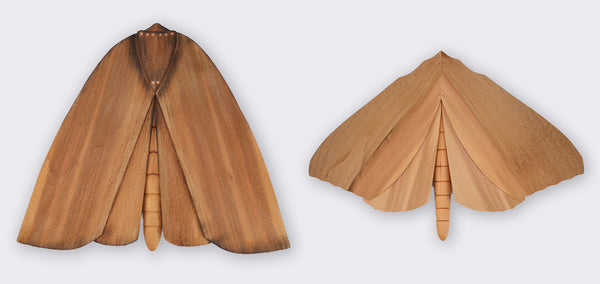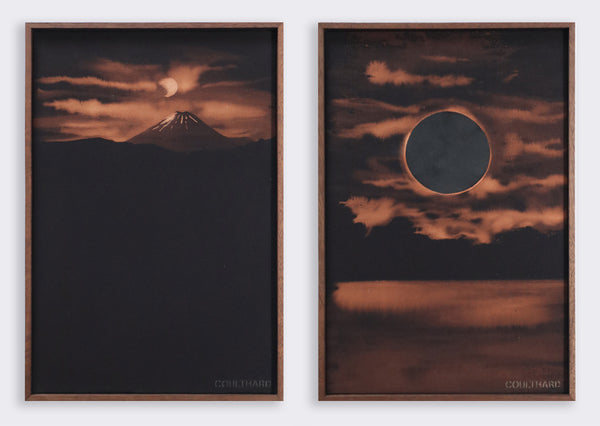02 - 12 November 2023
The Poi Room, 17 Osborne Street, Newmarket
An exhibition in three parts; an eclipse of Moths, Dark Eclipse and Light Eclipse.
Three stylistically different bodies of work all riff on the same theme.
Three stylistically different bodies of work all riff on the same theme.
The common understanding of an Eclipse is an obscuring of the light from one celestial body by the passage of another between it and the observer or between it and its source of illumination.
Eclipse is also the collective noun for a gathering of moths.
Although it is a mathematical inevitability due to the laws of physics, an eclipse is a rare and wondrous thing that grabs our attention and has long been seen as auspicious. My processes are as much about sculpture as painting. The inherent texture and colour of the substrate is an integral part of the work.
Below, Paula takes us through her methods and inspiration in her own words.
Dark Eclipse
Hypochlorite and Water Painting on Black Packduck Canvas, on hardboard. Dark Wood Tray Frame.

In these works I am painting the light with the celestial orbs as my muse. As the shadow of the moon crosses the sun, the world turns an eerie shade. Ranging from human scale on earth and soaring out into space and the imagination, there is an expansive aspect to these paintings.

In these works I am painting the light with the celestial orbs as my muse. As the shadow of the moon crosses the sun, the world turns an eerie shade. Ranging from human scale on earth and soaring out into space and the imagination, there is an expansive aspect to these paintings.
These works were conceived with the fortuitous discovery that hypochlorite* causes the black cotton canvas to turn a warm and brilliant peachy-orange. The idea of just painting the light on a dark surface is not new to me, but this technique is. It took some practice to master. It is a process of subtraction rather than addition. Getting the right ratio of hypochlorite to water, masking out, letting the materials do their thing with just the right balance of control.
When first painting with the hypochlorite solution it is invisible on the canvas and develops slowly like a photograph. When the painting is done I take the work outside and hose it down to stop the bleaching process. It is not until the canvas has fully dried that the completed artwork can be seen. There are no second chances with this. The artwork is either finished or it is ruined. The black cotton canvas has a deep matt black quality, the oxidising of the canvas changes the colour but not the texture. The colour change becomes a part of the cloth, rather than painted on. In “Black Dot”(#10) I have also used black paint as a contrast in black. The two blacks one deep and matt, one flat and textured. *Note: (hypochlorite is an ion composed of chlorine and oxygen with the chemical formula ClO−.) The hypochlorite oxidises the canvas and causes a bleaching effect.
LARGE MOON AND RA
Light Eclipse
Water based paint and water on stone washed and oxidised cotton canvas

Meditations on Celestial Orbs.
In the depths of our wet winter 2023 it felt like it had been raining for 6 months non stop. The nights were long, the days short. I was counting down to the shortest day. The thought of the sun made me feel happy. I decided to paint the sun, as a wish, as a prayer, as a visualisation.
I started with the sun but the other ideas I had been ruminating on started to emerge. Themes of eclipse, moving orbs, the dance of our solar system, light and shadow, and all of these in relation to us and how they affect us in the rhythm of our days. The phases of the moon, the length of the days, the heat of the sun, all come into play.

Meditations on Celestial Orbs.
In the depths of our wet winter 2023 it felt like it had been raining for 6 months non stop. The nights were long, the days short. I was counting down to the shortest day. The thought of the sun made me feel happy. I decided to paint the sun, as a wish, as a prayer, as a visualisation.
I started with the sun but the other ideas I had been ruminating on started to emerge. Themes of eclipse, moving orbs, the dance of our solar system, light and shadow, and all of these in relation to us and how they affect us in the rhythm of our days. The phases of the moon, the length of the days, the heat of the sun, all come into play.

These paintings reference relaxation techniques of zooming out, and also the inner world, visions of light when eyes are closed. They are both vast and personal, universal and cellular.

These works are painted on aged and wet canvas. The imperfections and character of the aged canvas brings warmth and story to these pieces. The wet painting technique brings atmosphere to the orbs. They are intuitive and joyful to create.
An ECLIPSE of MOTHS
Cedar Shingles, Japanese Cedar, Reclaimed Timber

One of the most magical nature moments of my life occurred at a party one winter in Raetihi in the central North Island. There was a bright spotlight shining to light up the lawn, which was bordered by native bush. That bright light drew Puriri Moths in their hundreds. They were massing in the light, huge and green. I was awestruck.

One of the most magical nature moments of my life occurred at a party one winter in Raetihi in the central North Island. There was a bright spotlight shining to light up the lawn, which was bordered by native bush. That bright light drew Puriri Moths in their hundreds. They were massing in the light, huge and green. I was awestruck.

The collective noun for a group of moths is an eclipse. I love the imagery of that - so many that they eclipse the light. My moths are symbolic of the variety and volume of the approx. 1600 moths and butterflies endemic to Aotearoa.
I was inspired to create a simple moth form where the texture and colour of the material is as important as wing shape.

To realise the moths I joined the Wairarapa Woodworkers Guild where I used wood from a fallen Japanese Cedar and reclaimed timber, turned it on a lathe, and into the bodies of the moths. The wings are made from Cedar shingles. The shingles have a beautiful texture and are tapered to a delicate wing tip.









